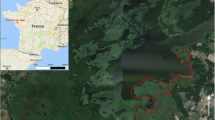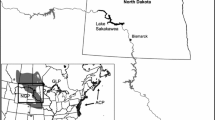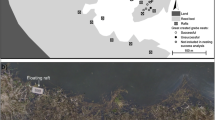Abstract
In the past 60 years, reservoirs have reshaped riverine ecosystems and transformed breeding habitats used by the threatened piping plover (Charadrius melodus; hereafter plover). Currently, 29 % of the Northern Great Plains plover population nests at reservoirs that might function as ecological traps because reservoirs have more diverse habitat features and greater dynamics in water levels than habitats historically used by breeding plovers. We examined factors influencing daily survival rates (DSR) of 346 plover nests at Lake Sakakawea (SAK; reservoir) during 2006–2009 by evaluating multiple a priori models, and we used our best model to hindcast nest success of plovers during 1985–2009. Our observed and hindcast estimates of nest success were low compared to published estimates. Previous findings indicate that plovers prefer nest sites that are low relative to water level. We found that elevation of nests above the water level had a strong positive correlation with DSR because water levels of SAK typically increased throughout the nesting period. Habitat characteristics on the reservoir differ from those that shaped nest-site selection for plovers. Accordingly, extraordinary nest loss occurs there in many years, largely due to inundation of nests, and based on low fledging rates those losses were not compensated by potential changes in chick survival. Therefore, our example supports the concept of ecological traps in birds because it addresses quantitative assessments of habitat preference and productivity over 25 years (since species listing) and affects a large portion of the population.







Similar content being viewed by others
References
Amat JA, Masero JA (2004) Predation risk on incubating adults constrains the choice of thermally favourable nest sites in a plover. Anim Behav 67:293–300
Anteau MJ (2012) Do interactions of land use and climate affect productivity of waterbirds and prairie-pothole wetlands? Wetlands 32:1–9
Anteau MJ, Sherfy MH (2010) Diurnal variation in invertebrate catch rates by sticky traps: potential for biased indices of piping plover forage. Wetlands 30:757–762
Anteau MJ, Sherfy MH, Wiltermuth MT (2012) Selection indicates preference in diverse habitats: a ground-nesting bird (Charadrius melodus) using reservoir shoreline. PLoS ONE 7:e30347
Arnold TW (2010) Uninformative parameters and model selection using Akaike’s information criterion. J Wildl Manag 74:1175–1178
Bayard TS, Elphick CS (2011) Planning for sea-level rise: quantifying patterns of saltmarsh sparrow (Ammodramus caudacutus) nest flooding under current sea-level conditions. Auk 128:393–403
Brown BT, Johnson RR (1985) Glen Canyon Dam, fluctuating water levels, and riparian breeding birds: the need for management compromise on the Colorado River in Grand Canyon. In: Johnson RR, Ziebell CD, Patten DR, Ffolliott PF, Hamre RH (eds) Riparian ecosystems and their management: reconciling conflicting uses. USDA Forest Service, Fort Collins, pp 76–80
Burger J (1987) Physical and social determinants of nest-site selection in piping plover in New Jersey. Condor 89:811–818
Burnham KP, Anderson DR (2002) Model selection and multimodel inference: a practical information-theoretic approach, 2nd edn. Springer, New York
Cairns WE (1982) Biology and behavior of breeding piping plovers. Wilson Bull 94:531–545
Catlin DH, Fraser JD, Felio JO, Cohen JB (2011) Piping plover habitat selection and nest success on natural, managed, and engineered sandbars. J Wildl Manag 75:305–310
Clark RG, Shutler D (1999) Avian habitat selection: pattern from process in nest-site use by ducks? Ecology 80:272–287
Cohen JB, Houghton LM, Fraser JD (2009) Nesting density and reproductive success of piping plover in response to storm- and human-created habitat changes. Wildl Monogr 173:1–24
Colwell MA et al (2011) Western snowy plovers Charadrius alexandrinus nivosus select nesting substrates that enhance egg crypsis and improve nest survival. Ibis 153:303–311
Daubenmire RF (1959) Canopy coverage method of vegetation analysis. Northwest Sci 33:43–64
Elliott-Smith E, Haig SM (2004) Piping plover (Charadrius melodus). In: Poole A (ed) The birds of North America online. Cornell Lab of Ornithology, Ithaca
Elliott-Smith E, Haig SM, Powers BM (2009) Data from the 2006 international piping plover census. US Geological Survey Data Series 426
Espie RHM, Brigham RM, James PC (1996) Habitat selection and clutch fate of piping plovers (Charadrius melodus) breeding at Lake Diefenbaker, Saskatchewan. Can J Zool 74:1069–1075
Foley JA et al (2005) Global consequences of land use. Science 309:570–574
Goswami BN, Venugopal V, Sengupta D, Madhusoodanan MS, Xavier PK (2006) Increasing trend of extreme rain events over India in a warming environment. Science 314:1442–1445
Gotmark F, Blomqvist D, Johansson OC, Bergkvist J (1995) Nest site selection: a trade-off between concealment and view of the surroundings? J Avian Biol 26:305–312
Haig SM, Oring LW (1988) Mate, site, and territory fidelity in piping plovers. Auk 105:268–277
Harris WC, Duncan DC, Franken RJ, McKinnon DT, Dundas HA (2005) Reproductive success of piping plovers at Big Quill Lake, Saskatchewan. Wilson Bull 117:165–171
Hays H, LeCroy M (1971) Field criteria for determining incubation stage in eggs of the common tern. Wilson Bull 83:425–429
Hutto RL (1990) Measuring the availability of food resources. Stud Avian Biol 13:20–28
Ivan JS, Murphy RK (2005) What preys on piping plover eggs and chicks? Wildl Soc Bull 33:113–119
Johnson DH, Shaffer TL (1990) Estimating nest success: when Mayfield wins. Auk 107:595–600
Jones LK (1997) Piping plover: habitat selection, home range, and reproductive success at Cape Cod National Seashore, Massachusetts Wildlife and Fisheries Conservation. University of Massachusetts, Amherst
Koivula K, Ronka A (1998) Habitat deterioration and efficiency of antipredator strategy in a meadow-breeding wader, Temminck’s stint (Calidris temminckii). Oecologia 116:348–355
Kruse CD, Higgins KF, Vander Lee BA (2001) Influence of predation on piping plover, Charadrius melodus, and least tern, Sterna antillarum, productivity along the Missouri River in South Dakota. Can Field Nat 115:480–486
Larson MA, Ryan MR, Murphy RK (2002) Population viability of piping plovers: effects of predator exclusion. J Wildl Manag 66:361–371
Mabee TJ (1997) Using eggshell evidence to determine nest fate of shorebirds. Wilson Bull 109:307–313
Mabee TJ, Estelle VB (2000) Assessing the effectiveness of predator exclosures for plovers. Wilson Bull 112:14–20
Martin TE (1998) Are microhabitat preferences of coexisting species under selection and adaptive? Ecology 79:656–670
Mayer PM, Ryan MR (1991) Electric fences reduce mammalian predation on piping plover nests and chicks. Wildl Soc Bull 19:59–63
Melvin SM, Macivor LH, Griffin CR (1992) Predator exclosures: a technique to reduce predation at piping plover nests. Wildl Soc Bull 20:143–148
Part T, Arlt D, Villard MA (2007) Empirical evidence for ecological traps: a two-step model focusing on individual decisions. J Ornithol 148:S327–S332
Patterson ME, Fraser JD, Roggenbuck JW (1991) Factors affecting piping plover productivity on Assateague Island. J Wildl Manag 55:525–531
Powell AN, Cuthbert FJ (1992) Habitat and reproductive success of piping plovers nesting on Great Lakes islands. Wilson Bull 104:155–161
Prindiville Gaines EM, Ryan MR (1988) Piping plover habitat use and reproductive success in North Dakota. J Wildl Manag 52:266–273
Rimmer DW, Deblinger RD (1990) Use of predator exclosures to protect piping plover nests. J Field Ornithol 61:217–223
Robertson BA, Hutto RL (2006) A framework for understanding ecological traps and an evaluation of existing evidence. Ecology 87:1075–1085
Rotella JJ, Dinsmore SJ, Shaffer TL (2004) Modeling nest-survival data: a comparison of recently developed methods that can be implemented in MARK and SAS. Anim Biodivers Conserv 27:187–205
Sargeant AB, Sovada MA, Greenwood RJ (1998) Interpreting evidence of depredation of duck nests in the Prairie Pothole Region. US Department of the Interior, US Geological Survey
Schlaepfer MA, Runge MC, Sherman PW (2002) Ecological and evolutionary traps. Trends Ecol Evol 17:474–480
Shaffer TL (2004) A unified approach to analyzing nest success. Auk 121:526–540
Shaffer TL, Thompson FR III (2007) Making meaningful estimates of nest survival with model-based methods. Stud Avian Biol 34:84–95
Sherfy MH, Stucker JH, Anteau MJ (2009) Missouri River emergent sandbar habitat monitoring plan—a conceptual framework for adaptive management. US Geological Survey, 2008–1223, p 51
Sherfy MH, Stucker JH, Buhl DA (2012) Selection of nest-site habitat by interior least terns in relation to sandbar construction. J Wildl Manag 76:363–371
Sovada MA et al (2000) Relationships of habitat patch size to predator community and survival of duck nests. J Wildl Manag 64:820–831
Thompson WL, White GC, Gowan C (1998) Monitoring vertebrate populations. Academic Press, San Diego
US Army Corps of Engineers (2010) Monthly reservoir summary (0168’s). US Army Corps of Engineers, Omaha
Vorosmarty CJ, Green P, Salisbury J, Lammers RB (2000) Global water resources: vulnerability from climate change and population growth. Science 289:284–288
Whitehead PJ, Tschirner K (1990) Magpie goose, Anseranas semipalmata, nesting on the Mary River Floodplain, Northern-Territory, Australia: extent and frequency of flooding losses. Aust Wildl Res 17:147–157
Whittingham MJ, Percival SM, Brown AF (2002) Nest-site selection by golden plover: why do shorebirds avoid nesting on slopes? J Avian Biol 33:184–190
Wiltermuth MT, Anteau MJ, Sherfy MH, Shaffer TL (2009) Nest movement by piping plovers in response to changing habitat conditions. Condor 111:550–555
Acknowledgments
This study was funded by the US Army Corps of Engineers’ Missouri River Recovery Program through financial and logistical support from the Corps’ Omaha District Threatened and Endangered Species Section and Garrison Project Office. We are grateful for technical support by the USGS Northern Prairie Wildlife Research Center Missouri River Least Tern and Piping Plover Research Team. We thank Melisa Bernard, Phil Brown, Deb Buhl, Tom Buhl, Colin Dovichin, Anthony Hipp, Coral Huber, Casey Kruse, Michael Morris, Brandi Skone, Nickolas Smith, and Ryan Williamson for help with project planning and logistics, and the many field technicians for their assistance with data collection. Lastly, we are indebted to Max Post van der Burg, Erin Roche, and anonymous reviewers for comments that improved the manuscript. Our field protocols were approved by the USGS Northern Prairie Wildlife Research Center Animal Care and Use Committee. Any use of trade, product, or firm names is for descriptive purposes only and does not imply endorsement by the US Government.
Author information
Authors and Affiliations
Corresponding author
Additional information
Communicated by Douglas Robinson.
Rights and permissions
About this article
Cite this article
Anteau, M.J., Shaffer, T.L., Sherfy, M.H. et al. Nest survival of piping plovers at a dynamic reservoir indicates an ecological trap for a threatened population. Oecologia 170, 1167–1179 (2012). https://doi.org/10.1007/s00442-012-2384-y
Received:
Accepted:
Published:
Issue Date:
DOI: https://doi.org/10.1007/s00442-012-2384-y




